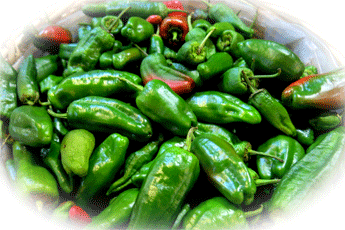Beware of the bite
While Spain may have been the nation that brought the Chilli to Europe, the Spanish people are not particularly fond of hot Chillies. While many countries use Chillies primarily for their spiciness, the Spanish prefer preparing their peppers as vegetables. They eat mainly milder Chillies with the spiciness only providing a subtle dimension to the flavouring.
The way the Spanish use the Padron Chilli in their cuisine illustrates this preference perfectly. This normally a mild Chilli is served as a Tapas dish. It is fried in olive oil until soft and blistered. It is then served with coarse salt. In other words, a fried vegetable with just a hint of spiciness. Or that’s the way it’s supposed to be. The Padrón doesn’t always play ball! Every now and then an unsuspecting diner will be struck by a really hot Padron. Even though considerable lengths are gone to ensure that these Chillies are mild, there is just no escaping that a couple will escape the net.
Or that’s the way it’s supposed to be. The Padrón doesn’t always play ball! Every now and then an unsuspecting diner will be struck by a really hot Padron. Even though considerable lengths are gone to ensure that these Chillies are mild, there is just no escaping that a couple will escape the net.
Padron Chillies are from the municipality of Padrón in the province of A Coruña, Galicia, northwestern Spain. Since 2009, they have had European protected designation of origin under their other name, Pimiento de Herbón. This status requires they must be traditionally and entirely manufactured (prepared, processed and produced) within a specific region and acquire unique properties. Meeting these criteria, it has the right to be solely authorized to use its particular name for marketing and other purposes.
The unique growing conditions, soil and water that allowed these Chillies (originally from Mexico) to become something unique to the Padron area. According to the Pemento de Herbon website, “these Peppers came originally from the Mexican state of Tabasco, where Franciscan monks living in the monastery in Herbón brought seeds from the 17th century and started growing them in the monastery garden. Over time, their growth was spread to all over the parish, becoming nowadays the most important crop. In the beginning, they were dried and ground to be used as a spice, being a principal source of income by the end of the 18th century.”
As part of this protection, farmers must ensure that the capsaicin content of the Chillies is no more than 10%. To achieve this, the Chillies are picked when they are young, and manual selection is performed to ensure that hotter Chillies are disposed of. Also, special seed selection techniques are used to attempt to achieve selective breeding. Despite all these measures, it is well accepted in Galicia that with Padron Chillies, you need to expect some will be hot.
The Padron Chilli grow into a bush of about 50 cm high and 40 cm wide. It produces pods of between 3 and 5 cm centimetres and ranges in colour from deep green to yellow-green. If allowed to ripen, its fruit will sometimes turn red. The riper Chillies will have a higher Capsaicin level
Comparing its taste to a Bell pepper may be a travesty, but its taste can only be described as being that of a greener, more concentrated Bell pepper with a subtle hint of heat. Whilst usually served as Tapas (sometimes with chunks of bread), Padrons can also be used in dishes like Pimientos de Padrón Rellenos de queso Tetilla (Padron chillies stuffed with Tetilla cheese), pickled Padrons and in stir-fries
Another great Chilli that found its way from one part of the world to another – to become a national favourite
Image Credits
Front link image: Maja Dumat / CC by 2.0/ via Flikr
Maja Dumat / CC by 2.0/ via Flikr
manual m.v / CC by 2.0/ via Flikr

